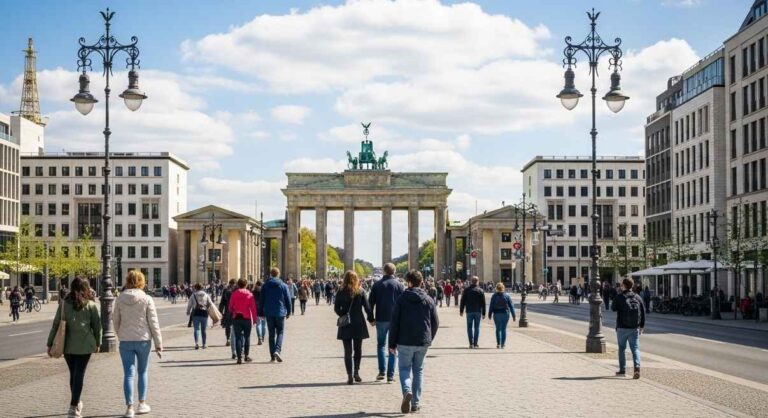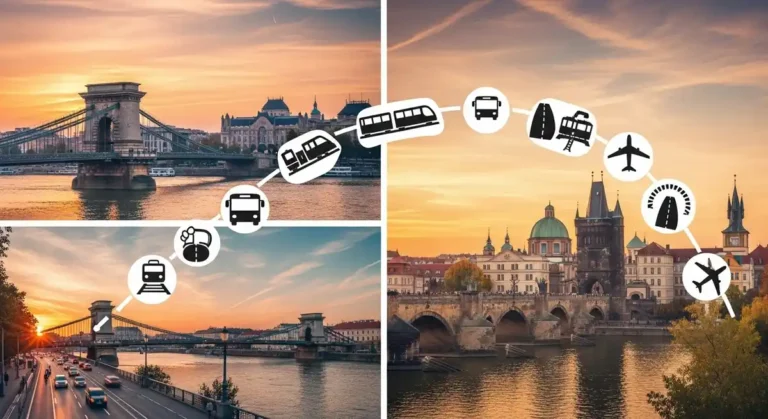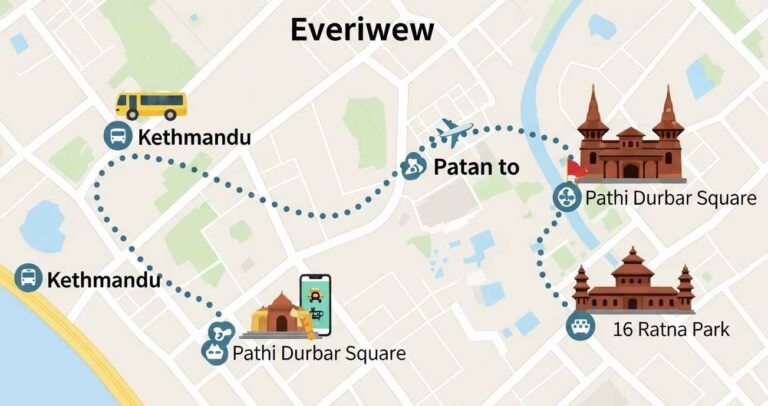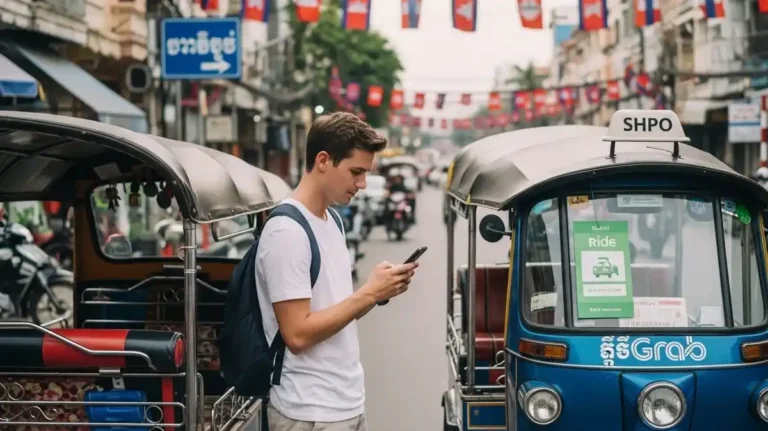No Uber in the Philippines? These 9 Ride Apps Are Better (2025)
There is no Uber in the Philippines, but travelers can use other reliable ride-hailing apps like Grab, Angkas, JoyRide, and Move It for car and motorbike taxi services.
Uber no longer operates in the Philippines, but getting around is still easy.
Grab is the most popular ride-hailing app and offers a smooth travel experience with car taxi options across the region.
- No Uber Since 2018: Uber stopped operating in the Philippines after merging with Grab in 2018.
- Grab is the Main App: Grab is the most popular and reliable ride-hailing app, offering cars, food delivery, and more.
- Motorbike Taxis Available: Apps like Angkas, JoyRide, and Move It provide fast motorbike taxi services in major cities.
- Other Alternatives: inDrive (fare negotiation), TADA, Lyft, and MiCab offer safe and flexible travel options.
- Safe in 2025: Ride-hailing apps have strong safety features like real-time tracking, verified drivers, and cashless payments.
- Taxi Upgrades: Taxis in 2025 are cleaner, include electric options, and are better regulated with apps like Grab.
- Common Scams: Overcharging, broken meters, and long routes still exist—use apps to avoid them.
- How to Use Apps: Download the app, sign up, set pickup/drop-off, book ride, pay, and rate the driver—very user-friendly.
- Best for Tourists & Expats: Grab, Angkas, Sakay.ph, 12Go, Waze, Google Maps, and Klook help make travel smooth and efficient.
- No Uber for Foreigners: Foreigners cannot use Uber in the Philippines, but Grab and others are fully accessible with global numbers.
For quicker rides on two wheels, motorbike taxi services like Angkas, JoyRide, and Move It are also widely used.
Uber once competed with Grab in Southeast Asia, but it sold its local operations and took a share in Grab.
Since then, Grab has become the dominant taxi app in the Philippines, offering reliable ride-hailing services for both locals and those travelling from abroad.
What Happened to Uber in the Philippines?
Uber stopped operating in the Philippines in 2018 after it merged with Grab, making Grab the main ride-hailing app in the country.
Uber offered a popular ride-sharing service in the Philippines until 2018.
That year, Uber joined with Grab and passed on its Southeast Asia operations, including those in the Philippines.
This move helped bring services under one dominant platform for easier access.
Before the change, there were steps taken by the Land Transportation Franchising and Regulatory Board (LTFRB) to guide driver applications and manage unregistered drivers.
In July 2017, new driver sign-ups were paused, and by August 14, 2017, Uber agreed to a one-month suspension.
Support was also given to drivers through financial assistance, including $5.87 million and 190 million pesos in fines, helping ease the shift.
On March 26, 2018, the decision to exit the market was shared.
By April 16, 2018, Uber’s service end became official, and Grab took over, offering continued ride-hailing convenience for everyone in the country.
Best Ride-Hailing & Taxi Apps in the Philippines (2025)
Best ride-hailing and taxi apps in the Philippines include Grab, Angkas, Joyride, inDrive, Move It, TADA, and Lyft.
These apps offer safe, reliable, and easy-to-use transport options like motorbike and car taxis across major cities such as Metro Manila, Cebu, Davao City, and more.
Features like Share Your Trip, in-app calls, and fare negotiation make them helpful for locals and travelers alike.
The Philippines offers many smart choices for getting around. Whether you prefer motorcycle taxis, private cars, or on-demand transportation, these apps give you plenty of options.
All major apps work across key cities and give users a smooth and secure travel experience.
You can pay with cash or card, and every mobile app is available on Google Play and the Apple Store.
These apps are designed to fit different routes, fare preferences, and service types.
Grab
Grab is still the #1 app in the Philippines because of its wide range of services, user-friendly features, and strong presence across the country.
Grab offers reliable ride-hailing, food delivery, package delivery, and even grocery shopping through one super app.
Its user-friendly interface makes it simple to book rides, track deliveries, and make cashless payments using GrabPay.
With a dominant market share, Grab has built an extensive network of drivers and delivery personnel in numerous cities.
The app is known for its reliable service, safety features, and driver training programs, making it a top choice for both Filipinos and foreign travellers, including solo female travellers.
Grab’s integration with GrabRewards offers loyalty benefits, and its convenience has made it the go-to app for daily transportation and delivery services.
In a safe country where people commonly speak English, using Grab is easy for asking directions or getting information, and it truly works like Uber—only more locally adapted.
Angkas
Angkas is a trusted motorbike taxi app. It operates in Metro Manila, Cebu, and Cagayan de Oro. With well-trained riders and strong safety features, it’s perfect for quick city rides and offers a great user experience.
Joyride
Joyride is a strong contender offering both car and motorcycle taxis. It’s known for smooth service and wide availability in places like Rizal, Cavite, Bulacan, Laguna, and Cebu. It’s easy to download, simple to use, and reliable for daily transportation.
inDrive
inDrive stands out because it lets users negotiate fares with drivers. It gives control over the pricing and is popular for its flexibility. It’s a great alternative for those who want more say in their fare and route.
Move It
Move It is a motorbike taxi app built for reliability and safety. With smart features like Share Your Trip and strong presence in Metro Manila, Cebu, and Cagayan de Oro, it’s a fast-growing platform that meets everyday travel needs.
TADA
TADA offers both private cars and taxis through its app. It’s gaining presence across the Philippines and is a solid option for users looking for on-demand transportation.
Lyft
Lyft is also available in the Philippines and works like Uber. Though it has a smaller operation, it remains a trusted app for those familiar with its platform in other regions of Southeast Asia.
Are Ride-Hailing Apps Safe in the Philippines in 2025?
Ride-hailing apps in the Philippines are safe in 2025, with strong safety features like real-time tracking, verified drivers, in-app communication, and secure, cashless payments making them a trusted and convenient choice for travelers.
Ride-hailing apps like Grab have become a safe and reliable way to travel in the Philippines in 2025.
These apps offer excellent safety features such as driver verification, background checks, and real-time tracking, which help protect passengers and improve trust in the system.
They also include in-app communication, so riders can easily contact the driver.
Panic buttons and other emergency features are added for extra support when needed.
With cashless payments and secure transactions, users avoid handling cash, which helps reduce worries about robbery or scams.
Transparent pricing is another plus. Riders can view the fare displays ahead of time, avoiding surprises or overcharging.
Even during peak hours with surge pricing, the price is clearly shown in the app, helping people plan their budget better.
Overall, ride-hailing in 2025 offers a safer alternative to traditional taxis and ensures a smooth, enjoyable ride across both cities and smaller areas of the Philippines.
How to Use Taxi & Ride-Hailing Apps (Step-by-Step)
Using taxi and ride-hailing apps like Uber or Careem is very easy. These apps make it simple to get a ride anytime, anywhere.
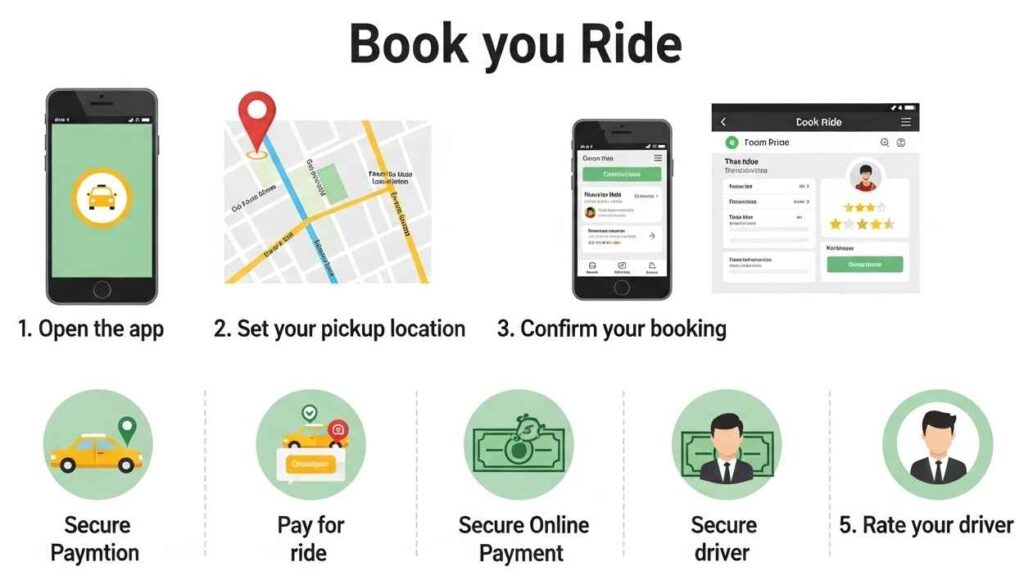
Here’s a clear step-by-step guide to help you:
✅ 1. Download and Install the App
- Go to your phone’s app store.
- Search for a trusted ride-hailing app like Uber or Careem.
- Tap install and wait for it to download.
✅ 2. Create and Register an Account
- Open the app and tap sign up or register.
- Use your email, phone number, or social media to create an account.
- You may need to log in each time you use the app.
✅ 3. Set Pickup and Drop-off Locations
- Enter your pickup location (where you are now).
- Add your destination (drop-off location).
- The GPS will help auto-fill your current location.
✅ 4. Choose a Vehicle Type
- Select the type of vehicle you need: standard, larger, or luxury.
- See the estimated fare and choose what suits your budget.
✅ 5. Confirm the Booking
- Review the ride details like fare, driver information, and wait time.
- Tap confirm to book your ride.
- The app will match you with a driver and display their details.
✅ 6. Track Your Ride in Real-Time
- Watch your driver’s progress on the map with real-time updates.
- You can see the estimated time of arrival clearly.
✅ 7. Make the Payment
- Pay using your credit card, mobile wallet, or cash.
- Many apps offer secure in-app payment methods.
✅ 8. Rate and Review Your Experience
- After the ride, leave a rating for the driver.
- Add feedback to help maintain service quality.
- Your review helps others have a better experience too.
These steps help make your travel smooth, quick, and reliable using ride-hailing apps.
Taxis in the Philippines (2025 Update)
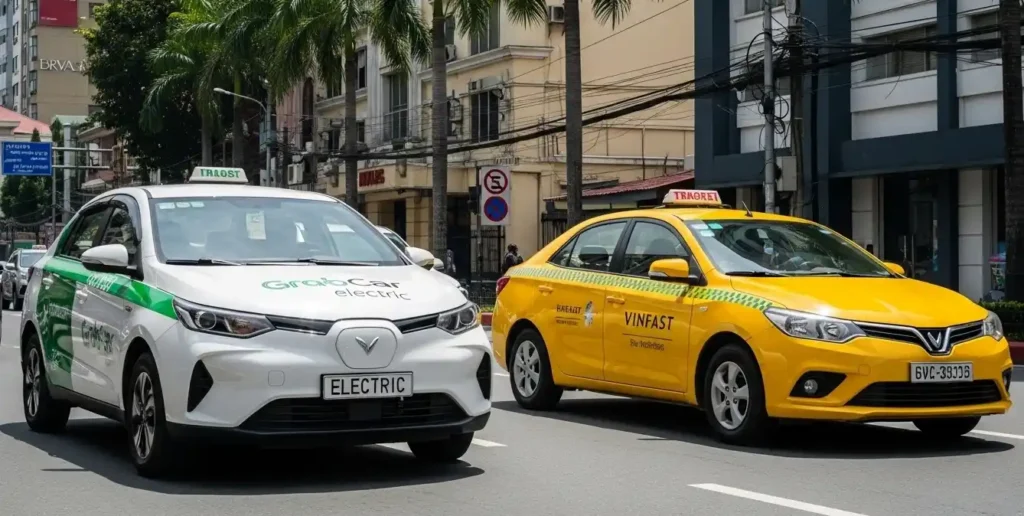
In 2025, taxis in the Philippines are more advanced, cleaner, and easier to use than ever before.
With the launch of electric taxi fleets, including Green GSM’s VinFast Nerio EVs and GrabCar’s electric vehicles, cities like Metro Manila, Davao, and Cagayan de Oro are seeing a shift to eco-friendly transport.
Ride-hailing apps like Grab, Angkas, Move It, and JoyRide allow quick and app-based booking, offering both comfort and safety.
These services use trained drivers, S2S monitoring systems, and dedicated pick-up points to provide a five-star experience.
The government, through LTFRB, continues to support growth with clear regulations and support for job creation in the transport sector.
Many passengers, including foreigners, find these taxis affordable, modern, and well-suited for both short and long rides.
Whether you’re commuting daily or visiting as a tourist, Philippine taxis in 2025 offer dependable and smart travel solutions.
Types of Taxis in the Philippines:
- Car Taxi – Traditional taxis hailed on the street or booked via the Grab app.
- Motorbike Taxi – Quick two-wheeler rides via Angkas, JoyRide, or Move It apps.
- Tricycle – Three-wheeled vehicles for short and local trips, especially in small towns.
This blend of technology, regulation, and sustainability shows how transportation in the Philippines is evolving to meet modern needs efficiently.
Common Taxi Scams to Avoid in the Philippines

Common taxi scams to avoid in the Philippines include overcharging, claiming a broken meter, and taking longer routes.
Use official taxi stands, ride-hailing apps like Grab, and always check or agree on fares before the trip to ensure a smooth and fair ride.
When taking taxis in the Philippines, it’s helpful to stay informed and prepared.
Some drivers may offer a pre-arranged fare instead of using the meter, especially near airports or tourist areas.
Others may take longer routes to increase the fare or add extra fees without proper explanation.
Using traditional taxis is fine, but make sure the meter is working. Some may claim it’s broken, so you’ll need to negotiate the fare carefully.
It’s best to know the approximate price of your trip by doing a little research beforehand.
Also, record the plate number, stay mindful, and communicate your trip details with someone.
Ride-hailing apps like Grab are very reliable. They show fixed prices, transparent routes, and allow payment by cash or card.
If there’s any concern, you can report it through the app, and platforms like Grab can even reimburse incorrect charges.
How to Avoid Taxi Scams
- Use ride-hailing apps like Grab for a safe and clear journey.
- Insist on the meter when using regular taxis.
- Pre-book your trip from official stands, especially at airports.
- Note the plate number and share it with someone you trust.
- Challenge unfair fares politely and report any issues to the LTFRB or relevant authorities.
- Stay aware, confident, and be ready with information that helps keep your trip smooth.
These simple steps help travelers enjoy a safe and fair taxi experience in the Philippines.
Grab-Specific Safety & Pricing Issues in 2025
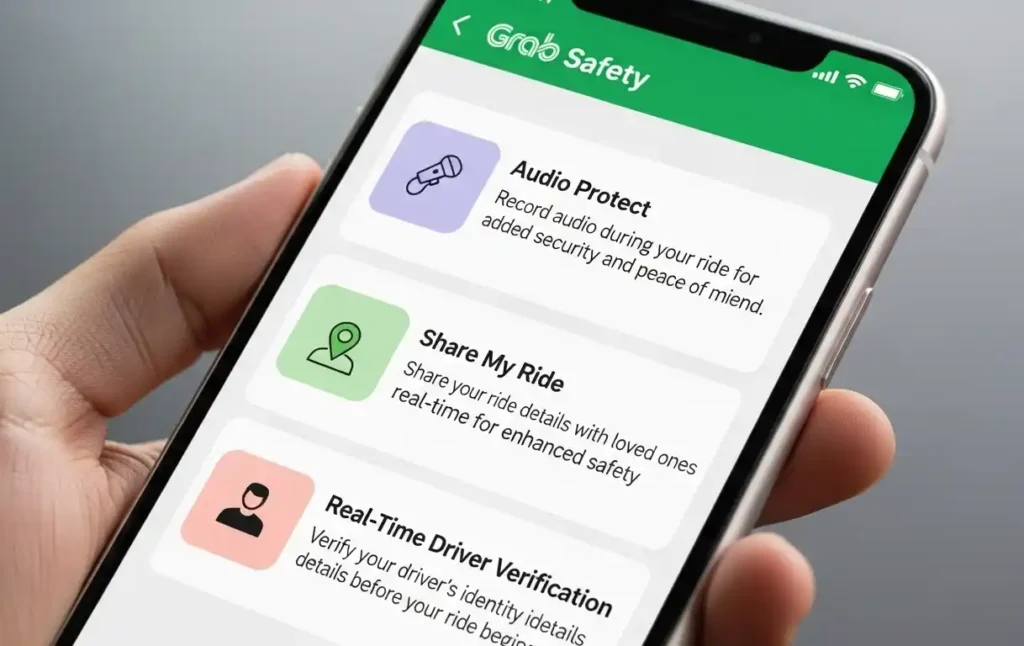
In 2025, Grab continues to improve its safety and pricing systems in the Philippines to offer a smooth ride experience.
The app now includes features like Audio Protect, which records rides for extra security, and Share My Ride, allowing users to share trip details with others.
Driver identity verification has become stronger with real-time selfie checks to ensure trusted driver partners.
To support accessibility, the platform offers better in-app communication for deaf and hearing-impaired drivers. Even details like seatbelt access are being improved to meet safety needs.
Grab is also helping drivers with the rising fuel price by providing a Fuel Resilience Package, fuel discounts, and optimized trip matching to reduce fuel consumption.
These efforts help maintain income stability for active drivers while improving ride efficiency for users.
On the pricing side, Grab is improving fare transparency. The app explains surge pricing more clearly and shows when and why pricing changes during peak hours.
A small platform fee increase was added, but the platform ensures that riders receive quality service and driver partners are well supported.
With better enforcement, stricter policies, and upgraded services like GrabAirport for easy airport travel, Grab ensures mobility remains reliable, secure, and user-friendly for both foreign visitors and local riders in 2025.
Best Transport Apps for Tourists, Expats & Locals
Grab is the most widely used ride-hailing app in the Philippines. It allows users to book a car, taxi, or motorcycle, and also offers food delivery.
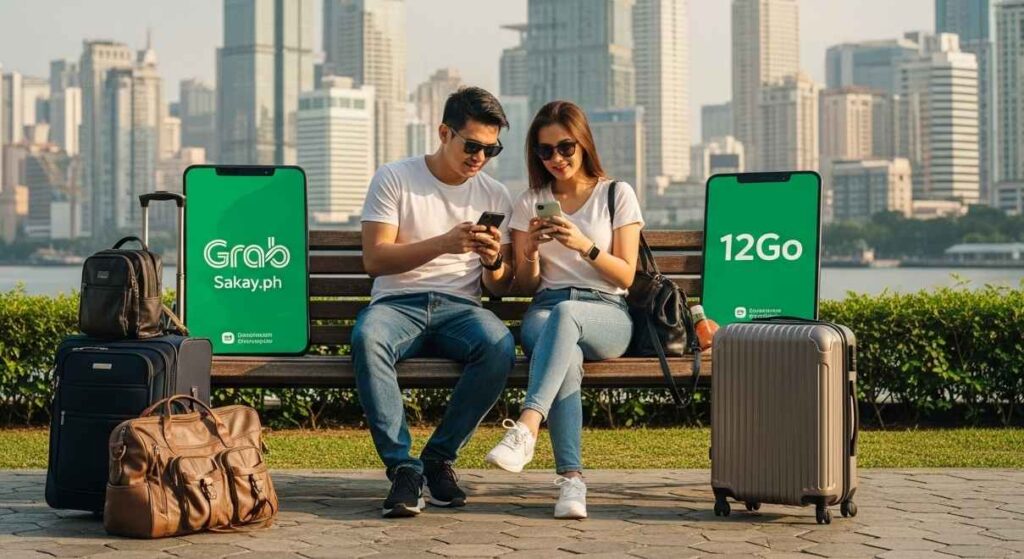
It’s known for being accessible, user-friendly, and reliable across many cities.
Angkas is ideal for quick motorcycle rides through traffic, especially in congested areas. It’s fast and helps save time in urban travel.
Another solid motorcycle option is Move It, which includes extra safety features like trip sharing and emergency contact.
To plan public transport in Metro Manila, Sakay.ph is extremely helpful. It shows directions for buses, trains, and jeepneys.
If you’re traveling between cities or islands, 12Go lets you book ferries, buses, and airport transfers easily.
Navigation is smooth with Waze and Google Maps, both offering real-time traffic updates, route planning, and directions. For areas with no internet, Maps.me provides reliable offline maps.
For travelers booking tours, activities, or a SIM card, Klook is a one-stop app. The Travel Philippines official app is great for weather, attractions, and travel advisories.
To communicate easily, Viber and Whatsapp help you stay connected.
Language isn’t a barrier with Microsoft Translator, and for managing money, XE Currency assists with currency conversion and tracking exchange rates.
These apps together create a smoother, more enjoyable travel experience for tourists, expats, and locals alike.
Is There Uber in the Philippines for Foreigners
Uber is available in the Philippines for foreigners and can be easily accessed using an international phone number or an existing account.
Grab is also widely used and offers a convenient, affordable ride-hailing option throughout the country.
Foreigners visiting the Philippines can comfortably use Uber, though its availability may vary by location.
Users can log in with an existing Uber account or create one using an international phone number. This makes transportation seamless for international travelers.
In addition to Uber, Grab is a leading ride-hailing service in the Philippines. It is widely used, affordable, and considered a popular option for both locals and tourists.
Both services provide safe, reliable transport solutions that are easy to access via mobile apps, giving foreigners multiple choices for getting around efficiently.
Philippines Uber Alternative
The best alternatives to Uber in the Philippines are Grab, Angkas, JoyRide, and MiCab.
These ride-hailing apps offer convenient booking, reliable service, and affordable options for travelers and locals.
Grab is the most widely used and popular ride-hailing app in the Philippines. It provides various services such as ride booking, delivery, and online payment.
The platform is known for being reliable, extensive, and available in many cities.
For faster travel through traffic, Angkas offers motorcycle taxis that are both quick and affordable.
It is a preferred alternative for solo travelers who need to move efficiently in urban areas.
JoyRide is another trusted motorcycle and car service, offering competitive rates and a growing network across the country.
For those looking for regular taxi bookings, MiCab connects users with licensed taxis through a simple app interface, making travel safe and easy.
These alternatives to Uber meet various travel needs with multiple options, secure platforms, and efficient services tailored to local conditions.
Conclusion
Uber is no longer available in the Philippines, but the country offers many excellent ride-hailing alternatives. Grab is the most widely used app for car and taxi services. It’s known for its convenience, safety, and affordable pricing, making it ideal for both locals and tourists.
For motorbike transport, Angkas, JoyRide, and Move It are top choices. These apps are especially useful for beating traffic in busy cities like Manila and Cebu. They’re fast, easy to book, and run by trusted drivers.
Whether you’re using a car or motorbike, these apps ensure smooth and reliable travel across the country. They are popular, user-friendly, and perfect for those looking for efficient and modern ways to explore the Philippines without Uber.
FAQs – Uber & Taxi Apps in the Philippines (2025)
Does the Philippines do Uber?
No, Uber does not work in the Philippines anymore. It stopped in 2018. But people can use other apps like Grab, Angkas, JoyRide, and Move It for rides.
What is the Uber equivalent in the Philippines?
Grab is the main app like Uber in the Philippines. It offers car rides, motorbike taxis, and food delivery. It is easy to use and works in many cities.
Can foreigners use Grab in the Philippines?
Yes, foreigners can use Grab easily. They can book rides using an international phone number or their home country’s account. Grab works well for tourists.
Is Uber or Grab in the Philippines?
Grab is in the Philippines, but Uber is not. Uber left the country in 2018. Now, Grab is the top ride-hailing app and works like Uber.
Which country is Uber not allowed in?
Uber is not allowed in some places, like the Philippines, due to local laws or business changes. In the Philippines, Uber merged with Grab and left the market.
Why was Uber removed in the Philippines?
Uber left in 2018 after it joined with Grab. The change helped make Grab the main ride-hailing app in the country. It gave users one easy option.
Can I pay cash in Grab Philippines?
Yes, you can pay cash when using Grab in the Philippines. You can also use a card or GrabPay. The app gives many payment choices.
Is Uber available anywhere in Southeast Asia?
No, Uber is not available in Southeast Asia now. It sold its business in the region to Grab. Now, Grab is the main app in countries like the Philippines, Singapore, and Malaysia.
Can tourists use Grab without a local SIM?
Yes, tourists can use Grab without a local SIM. They can book rides using Wi-Fi and their own phone number. The app works the same for visitors.
Is it cheaper to take taxis or Grab?
Grab prices are clear and fixed. Sometimes it’s cheaper than taxis, and sometimes not. But Grab shows the fare before the ride, so it’s easy to plan.
Do all taxi apps accept cash?
Yes, most taxi apps in the Philippines accept cash. Apps like Grab, JoyRide, and MiCab also let you pay by card or wallet. You can choose what works best.
Disclaimer
This article is for informational purposes only. Services, app availability, and features may vary by region and time. Always check official sources or app stores for the latest updates. For more travel tips, visit TravelDrizzle.com.

